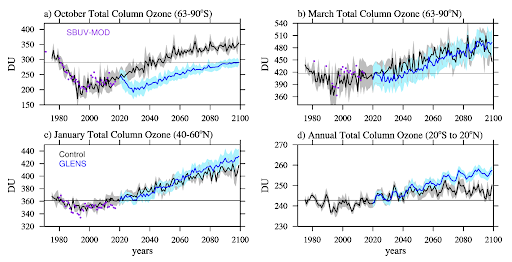Effects of Stratospheric aerosol intervention (SAI) on ozone
Stratospheric aerosol intervention (or Injections) (SAI) has been proposed to counter greenhouse gas-induced warming. Different sulfur injection strategies have been studied to limit some of the known side effects of SAI on the surface climate. Two papers in the last year have especially focused on the impacts of SAI on stratospheric ozone (Tilmes et al., 2021, 2022).
In the first study by Tilmes et al., (2021), explored the effects of these sulfur injection strategies on total column ozone (TCO) including effects on the recovery of the Antarctic ozone hole based on results from the Geoengineering Large Ensemble Simulation (GLENS) (Tilmes et al., 2018). The study finds that even a relatively slow phase-in of sulfur injections (producing a cooling of 0.5 degrees C in the first 20 years) is leading to an abrupt deepening of the Antarctic ozone hole in the first 10 years, reducing TCO by 8%–20% depending on the injection strategy (injection altitude and location). Other regions experience a moderate change of 5% in TCO. After 10 years, using a non-mitigated future scenario, TCO follows the recovering trend of the control simulation, delaying the ozone recovery by 25 to over 55 years (Figure 1, top left). For the Arctic spring, much less impact has been simulated (Figure 1, top right). In the Northern Hemisphere mid-latitudes in winter and spring (Figure 1,bottom left), SAI results in an increase of TCO and, combined with the effects of climate change, a ∼15% total increase. An increase in TCO is also simulated for this specific scenario in the tropics (Figure 1, bottom right). Both decreasing and increasing trends of TCO for different regions and periods are expected to impact ecosystems, which has to be further investigated.

Figure 1. Ensemble average of total column ozone for selected regions and seasons for the control simulations between 1975–2015, the 20-member control experiment between 2010 and 2030, and a 3-member continuation to 2100 using RCP8.5 emissions after 2015, with standard deviation (gray shaded area), 20 GLENS ensemble members with stratospheric sulfur injections between 2020 and 2100 (blue) with standard deviation (light blue shaded area). A 3-year running mean has been applied to the total column ozone observations from the Solar Backscatter Ultraviolet (SBUV) Merged Ozone Data set (Frith et al., 2017) (purple symbols) to be compared with the ensemble mean of the control simulation. The thin black lines in each panel indicate 1980 conditions.
The second study (Tilmes et al., 2022), is using output from the Geoengineering Model Intercomparison Project (GeoMIP) G6solar and G6sulfur experiment. For G6sulfur the stratospheric sulfate aerosol burden is increased to reflect some of the incoming solar radiation back into space in order to cool the surface climate (so-called stratospheric aerosol injections (SAI)), while for G6solar the global solar constant is reduced to achieve the same goal (so-called solar dimming. The high emissions scenario SSP5-8.5 is used as the baseline experiment and surface temperature from the medium emission scenario SSP2-4.5 is the target. Based on three out of six Earth System Models (ESMs) that include interactive stratospheric chemistry, we find significant differences in stratospheric temperature response and ozone distribution between G6solar and G6sulfur experiments compared to SSP5-8.5 and SSP2-4.5, which differ by both region and season. Solar dimming therefore should not be used as a proxy for SAI experiment. In addition, for SAI, the multi-model comparison supports results from GLENS (Tilmes et al., 2021), showing a significant reduction of total column ozone (TCO) in the Southern Hemisphere polar region in October of 10 DU at the onset of the injections and up to 20 DU by the end of the century. The relatively small reduction in TCO for the multi-model mean compared to GLENS in the first two decades results from variations in the required sulfur injections in the models. All models further show an increase in TCO in the Northern Hemisphere mid-latitudes in winter with increasing injections, consistent with earlier results. This study highlights that there is still a large uncertainty in the effects of SAI ozone and other impacts, due to differences in the complexity of the chemistry schemes, aerosol microphysics, and photolysis in models. (see alsoModeling Intercomparison Projects)
References:
Frith, S.M., R.S. Stolarski, N.A. Kramarova, and R.D. McPeters, Estimating uncertainties in the SBUV Version 8.6 merged profile ozone data set, Atmos. Chem. Phys.,17, 14695–14707, doi:10.5194/acp-17-14695-2017, 2017
Tilmes, S., Richter, J. H., Kravitz, B., MacMartin, D. G., Mills, M. J., Simpson, I. R., et al. (2018). CESM1(WACCM) stratospheric aero- sol geoengineering large ensemble project. Bulletin of the American Meteorological Society,99(11), 2361–2371. https://doi.org/10.1175/ BAMS-D-17-0267.1
Tilmes, S., Richter, J. H., Kravitz, B., MacMartin, D. G., Glanville, A. S., Visioni, D., Kinnison, D. E., and Müller, R.: Sensitivity of Total Column Ozone to Stratospheric Sulfur Injection Strategies, Geophysical Research Letters, 48, https://doi.org/10.1029/2021GL094058, https://onlinelibrary.wiley.com/doi/10.1029/2021GL094058, 2021.
Tilmes, S., Visioni, D., Jones, A., Haywood, J., Séférian, R., Nabat, P., Boucher, O., Bednarz, E. M., and Niemeier, U.: Stratospheric Ozone Response to Sulfate Aerosol and Solar Dimming Climate Interventions based on the G6 Geoengineering Model Intercomparison Project (GeoMIP) Simulations, Atmos. Chem. Phys. Discuss. [preprint], https://doi.org/10.5194/acp-2021-1003, in revision, 2022.